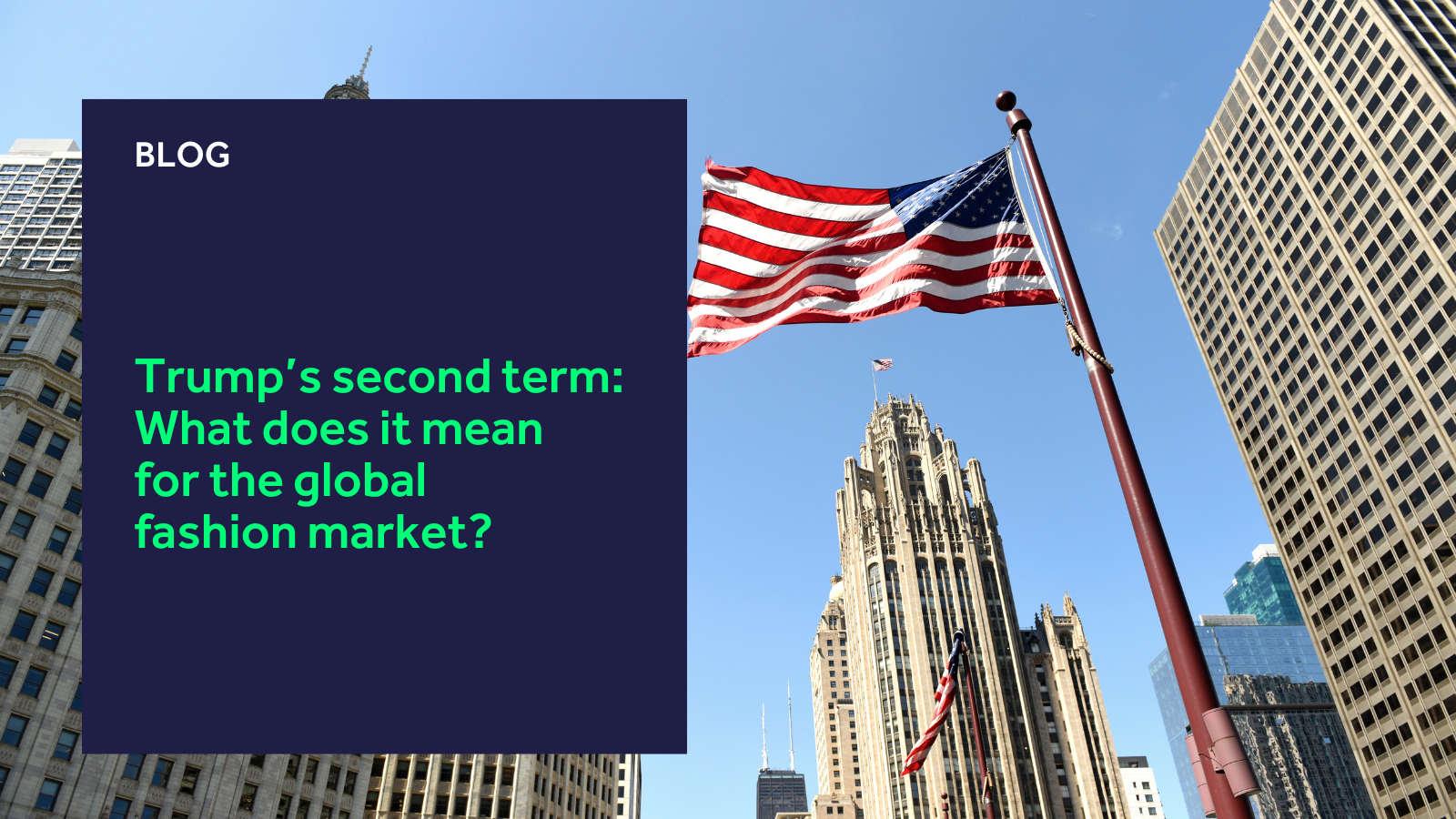Donald Trump’s return to the White House brings significant questions to the global fashion market. While his policies may indeed create opportunities for American-made fashion, they also bear risks for global supply chains, international trade, and environmental sustainability.
Trump’s policies extend beyond US borders, impacting an industry that operates globally and still maintains significant ties with European markets. Below, we explore the potential ways these policies will affect the market and what they mean going forward.
Tariffs, tariffs, and more tariffs
One of the most anticipated aspects of Trump’s trade policy is a renewed emphasis on tariffs, particularly on imports from China, which could reach 60% under his second administration.
As the Business of Fashion notes, for an industry where a substantial portion of goods is produced in Asia, the impact of such tariffs remains to be seen. Since the election was called, the value of the yuan has fallen significantly against the dollar, and it’s unclear how Chinese President Xi Jinping will retaliate to the anticipated tariff increases.
There are, of course, implications for US consumers too.
The National Retail Federation estimates that these tariffs could shrink American consumer spending power by $50 billion per year, in large because the increased costs the proposed tariffs will bring will be too large for US retailers to absorb.
Rather than taking the hit, US brands will instead pass the costs onto consumers by increasing retail prices, something that they are very open about. Speaking to The Washington Post, Columbia Sportswear CEO Timothy Boyle said:
“We’re set to raise prices. We’re buying stuff today for delivery next fall. So, we’re just going to deal with it and we’ll just raise prices… it’s going to be very, very difficult to keep products affordable for Americans.”
Given the US’ significant influence on the global economy, the tariffs’ impact will also reach Europe, particularly through ripple effects on multinational brands with significant exposure to the US. European companies – like LVMH – with extensive operations in the American market may see increased costs as they adapt to the new trade policies.
Shifting supply chains out of China to avoid tariffs isn’t a feasible option either, given the sheer scale and efficiency of Chinese manufacturing. European fashion players accustomed to stable US operations could face a period of increased logistical complexity and financial strain as their American counterparts adjust to the new tariff regime.
It’s also worth noting that while many expect tariffs to increase considerably, some are still sceptical that Trump would truly raise them by 60%. Nevertheless, experts assert that any tariff increases will inevitably lead to higher retail prices for consumers.
Putting America first
While the anticipated tariffs will likely cause complications for fashion companies outside the US, cautious optimism remains in the minds of many Americans.
Some observers see Trump’s return as an opportunity for brands focusing on “Made in America” products. Designers like Elena Velez have welcomed the focus on domestic manufacturing, seeing it as a potential boon for local artisans and smaller brands that can set themselves apart by embracing American-made goods.
This would indeed mark a notable shift, given that the US imports the majority of its apparel, accessories, and footwear. With that said, there will be challenges since, at present, the US cannot manufacture significant volumes domestically. Many believe it could take years for the US to scale production to meet current demand.
The bitter truth for the US is that its manufacturing infrastructure cannot match the quality-to-cost ratio that foreign factories offer, nor can they presently provide the same capacity.
While brands figure out how they can navigate domestic manufacturing, one counterweight Trump has touted to curb price increases is tax cuts. The president-elect campaigned heavily on promises that his administration would continue the tax cuts passed in his first term, alongside additional breaks.
Such a move would theoretically put more money into consumer pockets to account for the rise in prices on imported goods.
However, these moves will largely depend on whether they are passed, and that would require Democratic support. Whether Trump can achieve bipartisan support is another issue entirely.
U-turn on environmental policies
Many also expect Trump to roll back on environmental policies, given his history of dismissing climate change concerns and supporting fossil fuel expansion. His administration’s stance could weaken the momentum for sustainable practices in US-based fashion — a move directly at odds with the EU’s push for sustainability.
Pressured by stringent EU environmental standards, European fashion brands could face an additional competitive disadvantage against US-based competitors who, under a Trump administration, may not be subject to the same regulatory costs.
This policy shift may impact collaborations between American and European fashion houses, as sustainability remains a core focus for European consumers. Indeed, companies in Europe will likely continue pressing forward with their sustainability agendas while their American counterparts are likely to slow their own environmental endeavours.
Immigration, labour, and the cost of doing business
Trump’s stance on immigration also poses questions for the US fashion industry, which employs a significant number of immigrant workers. Stricter immigration policies could lead to a reduced labour pool, which, in turn, would increase wages and impact production costs for American brands dependent on this workforce.
For European brands with US manufacturing operations, such as high-fashion ateliers or retail staffing, the availability of skilled labour may decline, potentially leading to higher wages and, consequently, increased product costs.
This, combined with tariffs and a “buy American” emphasis, could drive some multinational brands to reconsider or even reduce their investment in US-based manufacturing and retail.
From an EU perspective, the heightened costs of doing business in the US could limit growth opportunities for European luxury brands targeting American consumers, especially if consumer spending tightens due to inflation or higher product costs.
However, that is just one scenario.
If Trump’s proposed tax policies are passed, luxury brands, even those based in Europe, could benefit from increased consumer spending among high-net-worth Americans.
The difficulty in ascertaining which way the market will go is in large part due to mixed investor sentiment. On the one hand, the Dow Jones rose on the back of Trump’s win… but on the other, shares of US retail giants like Nike, Lululemon and Gap fell.
The fall in share prices reflected concern over consumer demand under higher tariffs and potential trade barriers. Whether consumer spending and demand remains up is seemingly dependent on if – and that’s a big if – Trump’s tax policies are passed.
It’s not a simple path forward
Trump’s re-election introduces a web of sprawling paths forward. It isn’t clear. But it wouldn’t have necessarily been straightforward under a Harris administration either.
The reality is that no one can truly predict where the global fashion market is headed next.
Trump’s policies may support local American brands through tariffs and a focus on domestic manufacturing, but these measures risk straining global supply chains, increasing production costs, and potentially weakening the US-EU fashion relationship.
As with any period of political transition, the full impact will become clearer as policies are implemented. For now, global fashion brands find themselves in a landscape defined by uncertainty. Only time will tell what comes next.
Interested in reading more insights? Check out our resources page for more content about fashion.
 https://www.k3btg.com/wp-content/uploads/2024/03/K3-strengthens-global-market-position-blog-header.png
900
1600
Jordan Heal
https://www.k3btg.com/wp-content/uploads/2022/03/K3_Master_Colour_RGB.svg
Jordan Heal2024-03-11 10:58:242025-02-21 14:37:51K3 Fashion Portfolio strengthens global market position as Tony Bryant spearheads new role
https://www.k3btg.com/wp-content/uploads/2024/03/K3-strengthens-global-market-position-blog-header.png
900
1600
Jordan Heal
https://www.k3btg.com/wp-content/uploads/2022/03/K3_Master_Colour_RGB.svg
Jordan Heal2024-03-11 10:58:242025-02-21 14:37:51K3 Fashion Portfolio strengthens global market position as Tony Bryant spearheads new role

